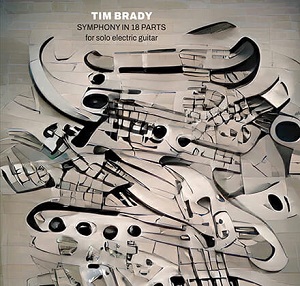
Tim Brady (b. 1956)
Symphony in 18 Parts, for solo electric guitar (2021)
Tim Brady (electric guitar)
rec 2022, Bradyworks and Silent Sound Studio, USA
Reviewed as a digital download from a press preview
Starkland ST-237 [50]
A symphony for solo electric guitar? I rather suspect that this is the reaction Canadian composer and electric guitar virtuoso, Tim Brady, was looking for. A symphony these days can mean whatever one wants it to mean but choosing that most loaded of descriptions means some kind of relationship with the past. There is a tension between this instrument, most associated with rock and definitely out on the fringes of classical acceptability, and the very idea of a symphony.
The tensions don’t stop there. It is cast in the form of 18 very disparate sections which seemed to provide the listener with a kind of conspectus of ways of playing the electric guitar – the range and diversity is stunning. But that in itself seems to work against the unity traditionally associated with the symphony. I found myself thinking first of the way Shostakovich made a symphony out of short songs in his 14th symphony, deploying a form – the song – not often associated with symphonic form. I also found myself thinking of works like Beethoven’s Op 131 which whilst not a symphony as such is built in a similarly mosaic manner. The issue of how much Brady’s work is a symphony in any meaningful way would seem to lie in how well its many sections and styles integrate themselves into a whole.
Before considering this issue, it would be remiss of me not to point out just how enjoyable Brady’s writing is. There is no sense of thin textures or limited musical range. It is probably no accident that the work begins with one of the parts that sound most like traditional rock music as if he were provoking the listener to think about the allowable scope of the term symphony. There are occasional bits that drag, but overall it is both a highly diverting listen and also a superb shop window for the electric guitar as a serious classical instrument. With the range of effects at his command, Brady challenges preconceptions at every turn. There is jazz here, minimalism and rock amongst much else. Each style is a jumping off point for Brady’s imagination rather than a copy or a pastiche. It provides him with a musical language with which to express himself.
Brady is a charismatic player and even in the more challenging passages he carries his inspiration across to the listener. The very issue of what might be challenging is challenged: will the listener have most difficulty with the hints of serialism or those parts that channel heavy rock?
There is an element of virtuosity for virtuosity’s sake at times as if this were a series of very diverting études. Like the best virtuoso pieces, it does offer greater depths than just dazzling us. The opening part behind its rock garb alerts us to an emotionally disturbed mood that runs through the symphony. Sometimes it is expressed in alienated terms reminiscent of krautrock and in others in the frenzy of prog. Even the placid moods that seem to grow out of Reich and Glass quiver with a nervousness that never really resolves itself. In his accompanying notes, Brady points out that this is both North American and specifically Canadian music and references the fact that Canada used to be known as the Mosaic Country. If this musical mosaic is a portrait of Canada then it seems to evoke dark undercurrents beneath the surface of that state.
I confess that the titles given by Brady to each part meant very little to me as a listener and the liner notes do not see fit to elucidate me further. This is unfortunate, as they might have helped me understand better the trajectory of the piece as a whole.
Turning back to the notion of a symphony, my observation is that it might have been more effective if its structure had been tighter. 18 parts is a lot to integrate and at times I found that it digressed a little too much to hold together as a single work. There are, of course, plenty of nineteenth century symphonies well established in the repertoire guilty of the same thing. It did make me think of this as a suite of pieces rather than as a symphony. Not because I was unconvinced that a symphony could be built out of such materials or played by this instrument. It just never quite sold me on the idea that it was a symphony. Ultimately, the issue is academic. It doesn’t matter whether it succeeds at some very loose task of connecting to the symphonic tradition. Listened to as just a piece of music it works very well and does succeed in making a case for the electric guitar within the classical sound world.
David McDade
Availability: Starkland

















